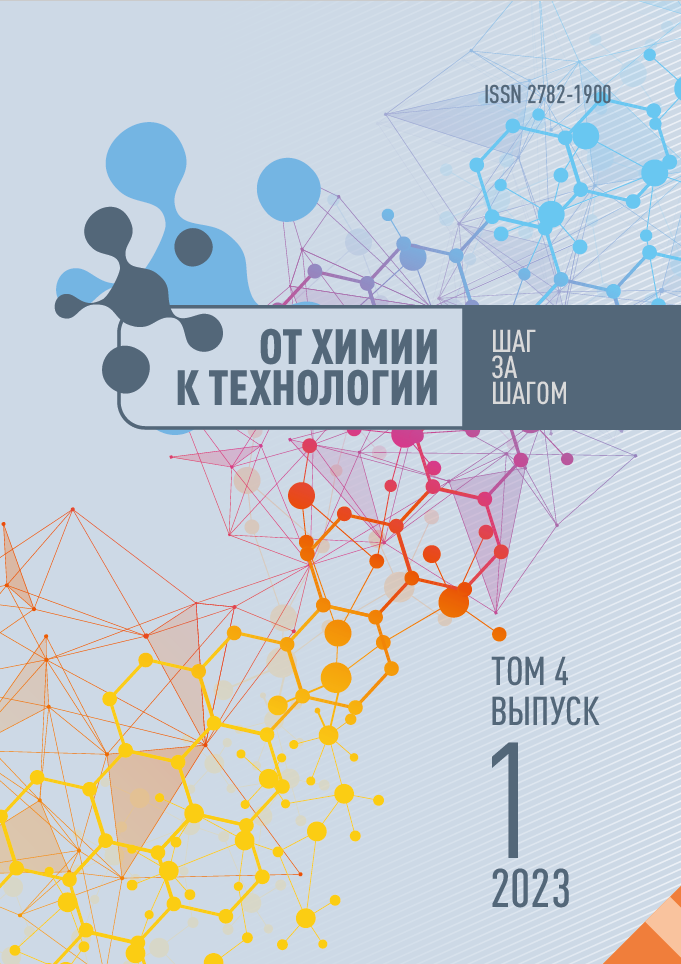аспирант
Ярославль, Ярославская область, Россия
студент
Ярославль, Ярославская область, Россия
сотрудник
Ярославль, Ярославская область, Россия
The paper presents a study of monoreduction selectivity process of 3,4'-NO2-4-R-benzophenones containing different functional groups. The presence of an electron-accepting substituent in the ortho-position of the nitro group facilitated its reduction, while electron-donating and bulk functional groups prevented it.
Mono-reduction, selectivity, asymmetrical dinitrobenzophenones, nitro group, nitroamines
1. Pinheiro, H.M., Touraud, E. & Thomas, O. (2004) Aromatic amines from azo dye reduction: status review with emphasis on direct UV spectrophotometric detection in textile industry wastewaters, Dyes Pigm, (61), pp. 121−139. DOI:https://doi.org/10.1016/j.dyepig.2003.10.009.
2. Bindra, A.P. (2006) Heat stable laked monoazo red pigment. 1668081 EP.
3. Waware, U.S., Hamouda, A.M.S. & Majumdar, D. (2019) Synthesis, characterization and physicochemical studies of copolymers of aniline and 3-nitroaniline, Polymer Bulletin, 77(9), pp. 4469–4488. DOI:https://doi.org/10.1007/s00289-019-02957-y.
4. Selvaraj. P., Subramani, K., Srinivasan. B., Hsu, C.-J. & Huang, C.-Y. (2020) Electro-optical effects of organic N-benzyl-2-methyl-4-nitroaniline dispersion in nematic liquid crystals, Scientific Reports, 10(1). DOI:https://doi.org/10.1038/s41598-020-71306-1.
5. Conoci, S., Petralia, S. & Sortino, S. (2013) Use of nitroaniline derivatives for the production of nitric oxide. 8440849 US.
6. Smirnov, S.P., Feshchenko, A.G. & Kiseleva, A.S. (2016) Method for the preparation of 5-amino-4,6-dinitrobenzofuroxane. 1841243 RU (in Russian).
7. Wei, H.Y., Xu, C.H., & Zhou, P.H. (2018) Method for synthesizing intermediate of Bendamustine hydrochloride. 108358848 CN.
8. Porter, H.K. (1973) The Zinin Reduction of Nitroarenes, Organic Reactions, 20(4), pp. 455-481 [online]. Available at: https://doi.org/10.1002/0471264180.or020.04
9. Hou. J., Ma, Y., Li, Y., Guo, F. & Lu, L. (2008) Selective Partial Hydrogenation of Dinitrobenzenes to Nitroanilines Catalyzed by Ru/C, Chemistry Letters, 37(9), pp. 974-975. DOI:https://doi.org/10.1246/cl.2008.974.
10. Grieco, G. & Blacque, O. (2021) Microwave-assisted reduction of aromatic nitro compounds with novel oxo-rhenium complexes, Applied Organometallic Chemistry, 36(1), e6452. DOI:https://doi.org/10.1002/aoc.6452.
11. Romero, A. & Cerecetto, H. (2020) A common, facile and eco-friendly method for the reduction of ni-troarenes, selective reduction of polynitroarenes and deoxygenation of N-oxide containing heteroarenes, Eu-ropean Journal of Organic Chemistry, 2020(12), pp. 1853-1865. DOI:https://doi.org/10.1002/ejoc.202000064.
12. Theodoridis, G., Manfredi, M.C. & Krebs, J.D. (1990) Selective hydrogenation of polynitroaromatic derivatives with noble metal catalysts in the presence of catalytic amounts of iron, Tetrahedron Letters, 31(43), pp. 6141–6144. DOI:https://doi.org/10.1016/s0040-4039(00)97008-4.
13. Terpko, M.O. & Heck, R.F. (1980) Palladium-catalyzed triethylammonium formate reductions. 3. Selective reduction of dinitroaromatic compounds, The Journal of Organic Chemistry, 45(24), pp. 4992-4993. DOI:https://doi.org/10.1021/jo01312a039.
14. Begunov, R.S. & Sokolov, A.A. (2022) One-reactor reduction and halogenation of n-(2,4-dinitrophenyl)piperidine, From Chemistry Towards Technology Step-By-Step, 3(2), pp. 30-36. DOI:https://doi.org/10.52957/27821900_2022_02_30. 481 [online]. Available at: chemintech.ru/index.php/tor/2022tom3no2 (in Russian).
15. Liu, S.S., Liu, X., Yu, L., Liu, Y.M., He, H.Y. & Cao, Y. (2014) Gold supported on titania for specific monohy-drogenation of dinitroaromatics in the liquid phase, Green Chemistry, 16(9), pp. 4162−4169. DOI:https://doi.org/10.1039/c4gc00869c.
16. Guillén, E., Rico, R., López-Romero, J.M., Bedia, J., Rosas, J.M., Rodríguez-Mirasol, J. & Cordero, T. (2009) Pd-activated carbon catalysts for hydrogenation and Suzuki reactions, Applied Catalysis A: General, 368(1-2), pp. 113–120. DOI:https://doi.org/10.1016/j.apcata.2009.08.016.
17. Yuan, M., Long, Y., Yang, J., Hu, X., Xu, D., Zhu, Y. & Dong, Z. (2018) Biomass sucrose derived co-balt@nitrogen-doped carbon for catalytic transfer hydrogenation of nitroarenes with formic acid, ChemSus-Chem, 11(23), pp. 4156-4165. DOI:https://doi.org/10.1002/cssc.201802163.
18. Leibzon, V.N., Michalchenko, L.V., Leonova, M.Y. & Gultyai V.P. (2005) Change in Regioselectivity in the Monoreduction of 2,4,6-Trinitrotoluene with Titanium(III) and Vanadium(II) Ions in the Presence of Iron(II) and Copper(II) Salts, Russian Chemical Bulletin, 54(5), pp. 1203-1207. DOI:https://doi.org/10.1002/chin.200629061.
19. McHugh, C.J., Keir, R., Graham, D. & Smith, W.E. (2002) Selective functionalisation of TNT for sensitive de-tection by SERRS, Chemical Communications, (6), pp. 580–581. DOI:https://doi.org/10.1039/b110972c.
20. Bellamy. F.D. & Ou, K. (1984) Selective reduction of aromatic nitro compounds with stannous chloride in non acidic and non aqueous medium, Tetrahedron Letters, 25(8), pp. 839–842. DOI:https://doi.org/10.1016/s0040-4039(01)80041-1.
21. Bilkis, I.I., Uskov, S.I., Galdilov, V.S. & Steingartz, V.D. (1986) Anion radicals of aromatic compounds. IX. Peculiarities of electronic structure of radical anion 1-substituted 2,4-dinitrobenzenes in aqueous and aqueous-alcoholic media, Zhurnal organicheskoj himii, 22(6), pp. 1247-1254 (in Russian).







